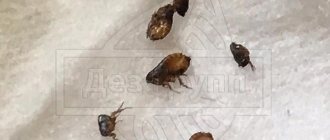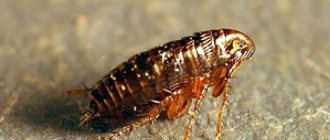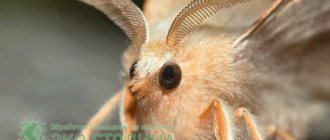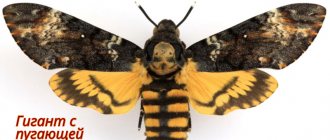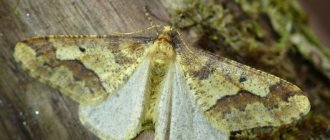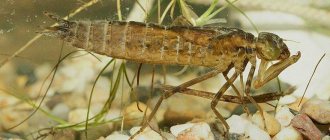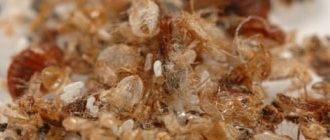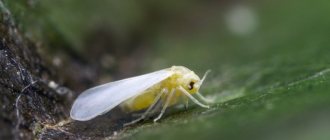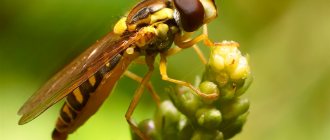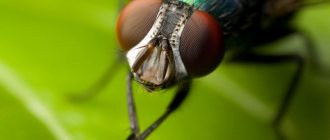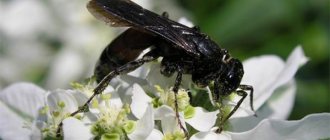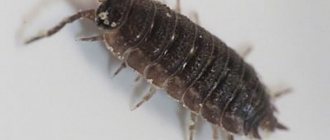Flour moth - Imago.
Flour moth - Imago.
Flour moth - Imago.
Flour moth - Imago.
Lifestyle of the great wax moth
Butterflies fly from May to September.
During the day they hide, and at nightfall the females enter the hives. First, the insect sits among the bees guarding the hive and freezes in a motionless position for 1-5 minutes. Then it quickly moves to the lower comb and lays eggs in batches in cells with fresh pollen or under the lids of not fully sealed cells with honey, less often in cracks and crevices of the hive or frame. Caterpillars (clochen) emerging from eggs often first scurry around in the debris at the bottom of the hive. After one day of life, they can crawl into new hives, and after the second day they begin to build characteristic straight tunnels in the honeycombs. Their passages have many branches and are lined with threads similar to a cobweb. After a short time, the larvae destroy the entire honeycomb.
Later, the caterpillars of the large wax moth attack the honeycombs with the worm and entwine them with cobwebs so much that the bees cannot emerge from the pupae. They can also mine honeycombs from the surface and eat the caps of sealed worms. When framed with wire, the caterpillars often hide in passages drilled into the wood. In untidy hives you can also see large wax moth pupae: they are in strong cocoons, connected into dense clumps.
The large wax moth at any stage of development dies at high and low temperatures: from 0°C and below, as well as at +45°C and above.
Having finished growing, the caterpillars look for a secluded place: a crack, crevice, folds of fabric. They can gnaw holes in honeycombs or foam. There they weave a cocoon for 2 days, the inside of which is fluffy and soft, the outside is dense. Near the top of the cocoon, the caterpillar makes an incision to facilitate its emergence as a butterfly.
The photo shows a honey bee honeycomb. On the left are the larvae, and on the right are the bee eggs. Photo credit: Waugsberg, CC BY-SA 3.0
How to get rid of it
Control of food moths should be carried out at all stages of insect development (from larvae to adults). The statement that to get rid of this butterfly you need to fight only its larvae, and the adult insect does not cause any harm to groceries, is fundamentally incorrect. The thing is that a butterfly flying from place to place can form an oviposition with about 160 eggs in each bag of cereals. Within a week, new larvae will hatch from them, which, naturally, will erode food products. And for this reason, protection against food moths must be comprehensive. In this case, the following measures are envisaged:
- At the initial stage, you should find places where moth larvae accumulate. For this purpose, all food products (especially flour and cereals) are sorted. Old food supplies are carefully checked for the presence of larvae and oviposition of the pest butterfly. If products infected with the pest are suddenly discovered, they are either completely thrown out, or (if there are too many infected products and their complete destruction will lead to serious losses) they are thoroughly heated in the oven for half an hour, setting the heating temperature to at least 60 ºC. Using this recommendation, you can remove most of the harmful insects from your home.
- It is possible to destroy ovipositions, larvae and adult moths that have settled in cabinets next to bulk food products by treating the internal surfaces of the cabinet with aerosols based on insecticidal components. Drugs in this category include Antimol, Armol, Raptor, known to many consumers, against food moths. You should not be too careful in choosing drugs to kill pest butterflies. The fact is that their destruction with aerosols is only an auxiliary and, most often, preventive operation, which, unfortunately, does not give 100% results. After all, food products cannot be directly treated with an aerosol product, and therefore the moth’s egg-laying eggs in them remain unharmed.
- It is much easier to destroy adult moths than larvae and eggs. For this purpose, experts recommend using regular sticky fly strips, which are sold in many hardware stores. You can also use the old-fashioned method - a rolled-up newspaper or a fly swatter. Due to the fact that food moths fly very poorly, it will be easy and simple to destroy them. A trap for food moths, for example Aeroxon, also demonstrates an excellent effect.
Trap for food moths
It has a specific aroma that attracts insect pests. The adhesive surface firmly holds unwary butterflies. The cost of such a trap is approximately 200 rubles, and you can purchase it in specialized stores or online.
At the moment, there are no simpler measures aimed at combating food moths. If this insect is found in a large production enterprise, then special fumigators containing phosphine are used to destroy it. Grain infected with moth larvae is sprayed with contact-acting insecticidal preparations. However, it is worth considering that such processing of food products cannot be done indoors - spoiled food is taken outside before disinfection.
Destruction
To destroy moths, spraying with insecticides, irradiation with insecticidal lamps and fumigation are used.
In small farms, spraying with solutions of tobacco and wormwood is used.
If the moth gets into the house and settles in the products in the kitchen, destroying them, then you can use Raptor traps, insecticidal plants - laurel, lavender, geranium, citrus peel, wormwood. All cabinets should be washed with a solution of vinegar and wormwood and lavender should be placed in them. This will scare away the moth.
The fire damages both large farms and small kitchens, destroying food supplies and turning them into dust. Therefore, it is necessary to fight it regularly, leaving the butterflies no chance of survival.
Signs of infection
Size of food moths and larvae.
It is not difficult to find out that there are moths in the house: fluttering grayish butterflies appear in the kitchen or in food pantries. Most often they can be seen in the evening: insects fly out to bask in the warm radiation of switched on electrical appliances. White caterpillars can be seen on cabinet doors, walls and even ceilings.
Pests lay eggs directly in food products. They do this on purpose: the hatched moth larvae need food. Cobwebs in semolina or flour are also a sign of infection: the adult caterpillar is spinning threads for a cocoon in which it will turn into an adult.
Genetics[ | code]
The mill moth is a model species used to study problems in phenogenetics, molecular genetics, cytogenetics and developmental biology. The karyotype consists of 30 pairs of chromosomes. Gender is determined by the ZW system. The mitochondrial genome is a circular strand of DNA consisting of 15,327 nucleotide pairs and contains 37 genes, of which 13 genes encode protein, two are rRNA and 22 are tRNA. About 0.7% of the DNA on the W chromosome is of mitochondrial origin, and 83% of the mitogenome sequence is present on the W chromosome.
Numerous variations in the mill moth's eye color caused by mutations have been described. Analysis of eye color mutations in Ephestia kuehniella
provided the first evidence for the "one gene, one enzyme" theory in classical genetics.
Currant moth: what to do at different times of the year
Particular attention is paid to currant bushes, on which the moth was noticed last season. The main task is to prevent the emergence of adult individuals at the beginning of the plant’s growing season.
Getting rid of adults is more difficult than getting rid of caterpillars. It is necessary to combat the moth taking into account the stage of development of the pest and the currant.
in spring
Activities begin before the sap flows: the currant bush is tied in a bunch and the root circle is poured with boiling water, and the plant is treated with water at a temperature of 60°C. In the second case, the method will help get rid of the bud mite and the currants will wake up faster.
After tilling the soil with a diameter of 60 cm, the soil is covered with film and left until the end of April. Once an adult emerges from the cocoon, it will not be able to fly out. Remove the cover after flowering is complete. The plant and soil are treated with Kinmiks. A week later, water with tobacco infusion and set traps for the moth.
In summer
There is no need to fight the moth in the summer if measures are taken at the beginning of the season. After appearing, the butterfly does not fly far if there are crops suitable for feeding on the site. Without allowing the pest to spread massively, you can get rid of it within one season.
After the ovaries appear, carefully inspect the bush for the presence of moth; if there is a problem, treat everything in the area, including gooseberries and raspberries, with Actellik. After five days, sprinkle with ash or spray with pine concentrate. Affected berries are removed from the bush by hand. A week before harvesting, use Fitoverm. After picking the berries, you can treat the plant with any insecticide.
in autumn
Autumn events:
- Prune the bushes if the plant is affected. A few strong branches are left, the rest are removed. In spring, the crop will form young shoots.
- Currants are hilled; a layer of soil will make it difficult for an adult insect to fly out.
- The root circle is sprinkled with ash and mulched.
Fertilize not only at the base of the bush, but also throughout the root circle
Pest prevention
You can prevent the appearance of moths in different ways. If we are talking about species that settle in the house and spoil food, for example, southern barn or dried fruit, then the following measures will help:
- ventilate the room as often as possible and clean regularly;
- periodically check supplies for the presence of larvae;
- Store food correctly, observe temperature and humidity conditions.
Food storage
If we are talking about species that harm garden or garden crops, then they are protected from pests as follows:
- after harvesting, all debris, weeds, plant debris are removed from the site, and the soil is dug up;
- 7 – 10 days before planting, the soil is treated with a weak solution of potassium permanganate;
- During the planting season, it is necessary to regularly weed and loosen.
Next to the beds you can plant plants that repel moths - lavender, wormwood, mint. The same can be done in the apiary to protect the hives from wax moths.
Some types [ | ]
In forestry they are important: spruce cone moth - Dioryctrica abieteila WV (sylverstrella Rtz.), a butterfly up to 30 mm in span, gray, fore wings with dark and white transverse, jagged stripes and with a white spot near the middle; caterpillar up to 20 mm long, dirty-reddish, with a brown head and occipital shield and with dark oblong stripes on the back and sides. At the end of June and in July, the butterfly lays eggs on spruce cones; caterpillars feed on immature seeds and scales. By the end of summer, the cones in damaged areas turn brown, fall off in September, the caterpillars emerge from them and cocoon in the soil cover for the winter, pupating in the spring. Less common in pine cones; Finally, they also develop in galls produced by Chermes on spruce and in painful thickenings of the bark from the fungus Pieridermium pini corticola, on pine - in whorls. The latter are described as a special variety - sylvestrella Rtzb. , or splendidella Hr. Sch. ; they pupate in the bark. Stenoptycha terebrella Zck lives in fir cones. , occasionally the previous one comes across; More often, caterpillars similar to them Retinia (Redweed) settle here. Zinkiella (Euzophera) pinguis Hw. develops in the bark of young ash trees. ; The caterpillars feed on layers of oak and sapwood. Finally, the seeds of white acacia (Robiniapseudoacacia) are eaten by the caterpillar Etiella Zinkenella Tr. , widespread in almost all forest districts of southern Russia, in other years it destroys crops everywhere; also little studied
In beekeeping, bloodworms and moths attract attention - the caterpillars of Galleria melonella L. (cereana L.) and Achroe agrisella Fbr. (alvearia L.)
The most famous in households are: flour moth - Asopia farinalis L., with a spread of up to 27 mm, violet-brown, with an ocher-yellow head; the fore wings near the middle are ocher-yellow, with two transverse white lines, of which the back one is strongly sinuous; both continue onto the hind wings; The 4th and 5th veins begin with a common stalk; the fringe has all the wings white, with dark spots; the hind wings are gray, their 8th vein is free. The caterpillar is yellow, grayish at both ends, with a red-brown head and occipital and caudal scutes. Lives in reserves of mealy substances, produces two generations per year, pupates in May, flies in June and July; found not only in Europe and Asia, but in North America, Brazil, Africa and the Tahiti Islands. Another species, Asopia costalis Fbr, lives together with it. In reserves of fatty substances, such as lard and oil, Aglossa pinguinalis L. is usually found - the female is up to 4 cm in span, the male is up to 2 1/2; without a proboscis, the labial tentacles are protruding, their last segment is bare, the maxillary tentacles are thread-like; shiny, brownish-gray color, the front wings with two black jagged stripes, yellowish on the outer sides and with a dark spot in the middle, the hind wings are light gray. Caterpillar up to 28 mm long, 16-legged, dirty-brown, head and occipital shield reddish-brown; On the sides of the body there is a deep fold of skin in which the breathing holes are hidden. They feed on fat, skin, pigeon droppings, and corpses; These same caterpillars were found in the vomit of people who apparently ingested them with food. Butterflies fly from late June to August. In seed warehouses, most often pine seeds, but also in dried fruits and hay dust, caterpillars of Ephestia elutella Hbn appear. ; butterfly up to 17 mm in span, on the front wings instead of the 7th, 8th and 9th veins there is only one, the 4th and 5th veins on all wings also merge, and the 7th and 8th on rear; the fore wings are brownish-gray, reddish at the inner edge, with two light gray, slightly sinuous transverse stripes and inconspicuous median points; the hind wings are light gray, almost white in males. Caterpillar up to 11 mm long, yellowish-white, with a yellow-brown head and occipital shield and with rows of the same warts along the back; the tail shield is darker. Flight of butterflies in July. Caterpillars are especially harmful in granaries, where they eat away seeds.
Dried fruit moth
External structure: The body of the butterfly is gray, 8-10 mm in length, wings 15-22 mm in span (females are larger). The front pair is dark gray or has a gray-ochre tint, interspersed with white-gray spots. The wings have two light transverse bands bordered by dark ones. There is a narrow light stripe along the outer edge. The hind wings are grayish and almost transparent, with darker veins and borders. The egg is 0.4-0.5 mm, white, covered with a mesh pattern. The caterpillar is 12-14 mm, white, with a darker head and rear end of the body. Covered with bristles. The pupa is dark brown in color.
Lifestyle: The species is tropical and has spread thanks to humans. Insects are very thermophilic, and a temperature of 28-32 °C is best for them. Females leave eggs not only on produce, but also on any other surfaces in storage. In total, one individual can have up to 350 of them. The caterpillars feed on grains and at the same time entwine them with their web, forming dense clumps. They pupate outside their nests, for this purpose they climb into floor crevices and onto the walls of storage rooms.
Prevalence: In heated rooms everywhere, except in the Arctic.
Harm: Seriously damage stored grain, depriving it of food and seed value. They contaminate products with toxic excrement and other waste products. Without treating the premises, they can infect newly brought shipments.
It is extremely dangerous to underestimate the damage that butterflies and moths can cause to stored grain. They can not only reduce the weight of food - no other type of pest clogs products so much with toxic substances and waste products. If measures are not taken in time, during long-term storage of grain contaminated with lepidoptera, you can lose all the valuable qualities of the product and lose profit from the sale. This situation can be prevented using quarantine phytosanitary disinfection. The First Fumigation Company will help you exterminate butterflies and all caterpillars hiding in the granary so that your product retains all its nutritional properties and seed qualities.
Description
Butterflies with a body length from 10 to 14 mm. The maxillary palps are filiform. The labial palps are curved upward and covered with appressed scales. The antennae of males have short cilia. The wingspan of males is 20.5–27.5 mm, and that of females is 17.5–24 mm. The front wings are dark gray or ash gray and have a pattern of two light jagged transverse lines. The hind wings are whitish, the wing margin and veins are darkened. The first radial vein of the forewing reaches the anterior margin of the wing at the level of the apex. The branches of the radial vein and the first medial vein on the hind wing reach the wing apex at the same distance from it. The color of the lower legs is brown-gray with light pollination. The paws are brown, with a light yellow band at the top. In males, on the eighth abdominal segment from above there are two pairs of short, simple, rather thin hair tufts. The ovipositor is long and retractable.
The eggs are oval, from 0.34 to 0.57 mm long. Newly laid eggs are white, turning yellow by the time the caterpillars hatch. The surface of the egg has a reticulate pattern of four to eight sinuous ridges, forming a tubercle at the junction. The eggs laid towards the end of the reproductive period become smaller. Usually the eggs are scattered chaotically, less often they are placed close to each other. Sometimes the eggs laid are arranged in a chain, with each egg leaning towards the neighboring one, forming a regular zigzag.
Mill moth caterpillar
The length of the caterpillars is 15-20 mm, width - 2-3 mm. The body is cream colored. The head and chest shield are brown. The third tooth of the mandible is shifted to the middle, so its outer edge is formed by the second tooth. The antennae are short and located on a protrusion. The mouthparts are directed downwards. On the sides of the head there is a group of six ocelli, which are located in a circle above the base and across the base of the antennae. The lower lip has a pair of tentacles and a long tubular arachnoid gland that produces silken webs. On the mandibles there are glands, the oily secretion of which falls on the arachnoid threads and on particles of the food substrate, holding them together. On the chest legs there are hooks arranged in three tiers.
On the first day of its existence, the pupa is yellowish-greenish, later becomes yellowish-brown, its length is 8-9 mm. The head and pronotum are wrinkled. The lower jaws, legs and antennae reach the end of the wing. The length of the visible part of the hind legs is 4-5 times greater than the width. The cremaster (tubercle at the end of the abdomen) is rounded, with eight hooked setae.
Flour moth
External structure: The body of the butterfly is 9-12 mm long, on the chest and at the junction with the wings it is covered with hairs with a purple tint and a silvery tint. The folded wings are almost triangular, the span is 18-30 mm. On the first pair, two wavy transverse bands separate the yellowish central part from the purple-brown base and apex of the wing. The pattern continues on the dark gray hind wings. It can lift up its red-brown abdomen, spreading its wings. The egg is white, 0.6 mm. The caterpillar is 15-22 mm, with a dirty white body, a rusty brown head and the tip of the abdomen. Pupa 9-12 mm, brown. Hidden from the outside by a spider cocoon.
Lifestyle: Adults lay eggs both in grain and on the walls of storage facilities. One female leaves up to 250 pieces. From 2 to 5 generations appear per year. Caterpillars live in small groups of several individuals, but each one weaves its own web tube. Resistant to low temperatures, successfully winter in storage. They pupate there or leave the grain mound, weaving a cocoon in the cracks of wooden walls or other hidden places.
Prevalence: In the southern regions they are field pests. They are not found only in the Far North of the Russian Federation.
Damage: They make nests on the surface layer of an embankment or in a small depression. They are polyphagous and are able to feed on both the nutritious parts of grains and the chaff remaining after the grain is exported. They clog products and reduce their quality characteristics. They can be brought along with the harvest from the fields or appear as a result of the dispersion of adults.
Cabbage moth
Cabbage moth is familiar to many gardeners. The larvae of this type of insect appear around May and June and eat cabbage leaves. By the end of June, the development of this stage ends, the caterpillars go into the soil, where they pupate. The butterflies fly in August, they lay eggs on the lower surface of the leaves of the same cabbage and weeds, and in the fall the second generation emerges from them, which overwinters in the soil and pupates in the spring of next year. In this case, the ovipositor period can be greatly extended - up to a month, sometimes longer.
Description
The cabbage moth butterfly has a wingspan of about 2.5-2.6 cm. The front pair is painted dirty yellow, the pattern is composed of two brownish stripes, between which there is a spot. The hind pair of wings is light yellow.
Cabbage moth butterfly
The cabbage moth larva is a caterpillar whose color changes from light yellow to yellow-green as it develops. The body size of a young larva is approximately 2 cm, an adult – 3 cm. There are two light, clearly visible stripes on the back. The head is light brown.
Maliciousness
The damage is caused by the larvae, which, having hatched from the eggs, begin to “scrape” the lower surface of the leaf blades, but no through holes are formed. As the caterpillars grow, they cause more and more noticeable damage, and older individuals can already gnaw out holes. In addition to cabbage, the diet of cabbage moth larvae also includes beets and horseradish.
Lesser wax moth
The female wax moth is 11.3 mm long, the male is 9 mm long. The wings range in color from dark ash gray to pale yellowish gray. There is a patch of yellow hairs on the forehead. Butterflies don't feed. Eggs are laid in crevices, sometimes in comb cells, a few hours after mating. 250-300 eggs are laid. The larvae emerging from the egg go through 5 stages of development. The full development cycle lasts 60-120 days. The optimal development temperature is from + 28* to + 30*. At temperatures below +16* and above +35*, moth eggs die. Only larvae overwinter in the hives. Caterpillars feed like large moths, but prefer to feed on beebread. One caterpillar eats 0.0075g per day. honeycomb The mediastinum is not damaged; passages are made through the walls of the cells on one side of the honeycomb. The passage is lined with cobwebs, and there is a lot of excrement in it. The signet of cells above the brood, where the moth caterpillar moves, has a tubular appearance. Raising the frame with the bees removed above a sheet of paper, when you hit the frame with a chisel, the caterpillars jump out. This method can get rid of many moth caterpillars. Frames are destroyed by clothing, fur, and furniture moths. The fight against moths must be carried out systematically.
The moth is a large family that includes more than 6 thousand species of insects. Among them there are also very small ones, but at the same time they turn out to be very serious pests of stocks, and real giants - butterflies with a wingspan of about 8.5 cm. Today we will get acquainted with representatives of the most common species. Some of them are quite curious, since, along with their harmfulness, they can bring significant benefits to humans.
Pests of grain and seeds
During storage, grain and seed material are damaged by numerous and diverse animal organisms.
From the class of Insects (Insecta) these are Lepidoptera (Lepidoptera), Coleoptera (Coleoptera), Hemiptera (Hemiptera) and others.
From the Arachnida class Acariformes (Chelicerata) Arachnida (Chelicerata) – Acariformes.
Insects that moved into granaries during evolution and found favorable conditions for development in them form a group of pests of grain and seeds. It unites a specific ecological group of insects capable of adapting to conditions significantly different from those of open landscapes. Among them there are species capable of developing equally intensively both in the field and in the granary. These are the Grain moth (Sitotroga cerealella), Moorish booger (Tenebrioides mauritanicus), Trogoderma teukton and others.
Most grain pests are polyphagous, feeding on a variety of foods of plant and animal origin. Many species are able to reproduce all year round without entering diapause, especially in constantly heated rooms. They often lead a hidden lifestyle (inside the grain, in the intergrain space, in the cracks of walls and floors). This complicates the implementation of protective control measures. In addition, natural enemies (entomophages and acarifages) and diseases (entomopathogenic fungi) weakly regulate the density of the pest population. This state of affairs leads to a rapid increase in numbers, which entails an increase in harmfulness and the ability to cause significant damage to grain reserves.
Grain and seed reserves suffer from the vital activity of representatives of the families of Moths and Moths of the order Lepidoptera. As a rule, caterpillars do the damage. Once in a suitable environment, they immediately begin to feed intensively. Most moths and moths are not freely distributed in nature. They lead a synanthropic lifestyle and live only in shelters created by people. This allows them to develop year-round, regardless of weather conditions. These species include: Cocoa moth (Ephestia elutella), Mill moth (Anagasta kuhniella) and others.
At the same time, a group of moths was established that has not lost contact with its natural habitats and is capable of developing and reproducing in natural conditions. The natural habitats of moths become insect reserves, from where they then freely enter uninfested food warehouses. These species include barn moth (Nemapogon granella), grain moth (Sitotroga cerealella).
The most common and harmful insects from the group of grain pests include beetles from the Weevil family (Curculionidae).
What pests are there?
When talking about food moths, as a rule, we mean the grain moth, without identifying the differences, and it can be identified by spoiled products - cereals, groceries, nuts. In fact, there are different types of moths, which, although similar to each other, have their own specifics.
The following main types of moths can be distinguished:
- The mill moth is less common. It is less conspicuous, having a rather nondescript color.
- Flour moth (flour moth) is the most common pest in common kitchens in both rural and urban areas.
- The southern barn moth (moth) has a beautiful, original pattern on its wings. It is the most difficult to deal with.
- The cocoa moth is common and is very similar to the box moth. It has an inconspicuous slightly yellowish tint to the wings.
In general, it is difficult to distinguish the food moth from the clothing variety, and therefore a conclusion is drawn about the insect based on its habitat. Other types of moths are accepted in everyday life - classified according to their preferred food. That is why concepts such as cereal, nut, pea and other moths are used. The cereal variety is found in buckwheat, millet, rice, etc., and the nut variety is found inside the nut.
Insect larvae are very voracious
Security
The total number of moths is declining, in many places it has become rare and is listed in various regional red books. In Belgium and the Netherlands, the moth has already become extinct. It is endangered in Germany and Sweden, considered vulnerable in Poland and Switzerland, and near vulnerable in Austria. It is a threatened species in northern France. It is included in the Carpathian Red List of Forest Habitats and Species as a vulnerable species in the Polish part and in a close to vulnerable position in the Czech, Ukrainian and Hungarian parts. In some countries, for example Finland and Germany, special measures are being taken to preserve this species. In addition, it is found in many protected areas. The main threat to the moth is habitat destruction, plowing of uncultivated land and other conversion to agricultural land, as well as intensive grazing and afforestation.
Folk recipes
Initially, it is advisable to combat this pest using gentle folk remedies, since it is not recommended to use chemicals during flowering or fruiting.
- Pharmaceutical chamomile - On the sixth day after all the buds have bloomed, they are thoroughly sprayed with tincture of pharmaceutical chamomile. To do this, stir 100 grams of dried chamomile flowers in a ten-liter bucket of hot water and leave for three hours until the tincture has cooled. After which they must filter.
- Pyrethrum powder - This antiparasitic powder, safe for humans and animals, is simply sprayed onto the buds and leaves of the bush every week.
- Wood ash is the most universal remedy against diseases and pests. It is convenient in that it can be used in both liquid and dry form. Ash treatment is carried out during fruiting. To do this, pour a glass of ash into a bucket of water, leave it in a dry place for about three days, and then water the entire bush. Then they scatter the ash around the trunk in a small layer and water the soil.
- Mustard powder - Many types of insect pests are afraid of it. Therefore, with its help you can successfully get rid of the moth. To do this, the powder is scattered throughout the bush. But you can also dissolve 100 grams of powder in a bucket of boiling water. Then let it sit for about two days and water the currants during fruiting.
- Tobacco - To repel moths, stir 400 grams of tobacco dust in a bucket of water and leave for two days. Then add a little grated laundry soap, filter and spray all the currants, trying not to miss a single section. If you use tar soap, it will protect the plant from fungal diseases and aphid invasion. Instead of tobacco, you can use wormwood tincture. The proportions for dilution are the same as for tobacco.
- Coniferous solution - With its help you can protect the bush from the invasion of caterpillars; for this, in early spring, everything is sprayed with pine concentrate, well diluted with water in the proportions of two tablespoons per bucket of water. This product can be purchased at any pharmacy. But if the caterpillars have already attacked the currants, then the amount of powder is doubled.
- Traps - To collect all the butterflies in one place, use a special trap that you can make yourself. To do this, take bright yellow cardboard, apply glue that does not dry out for a long time, and lay it out under the bushes. Soon many adults will stick to this cardboard.
- Elderberry - Branches with elderberry buds are hung throughout the bush; its aroma will repel both adults and their larvae. But you can also make a solution for spraying. To do this, 100 grams of dried elderberry flowers are infused in a bucket of water for two days. Then filter and spray.
All processing is carried out only in the evening, since the moth is active only at this time of day. And the weather should be dry and windless.
Where and why does it appear?
It is believed that a butterfly that spoils food cannot settle in a house just like that. Moreover, an insect of this species practically does not move by flying. It must be said that even a housewife who keeps her house perfectly clean is not immune from pest butterflies entering the kitchen. How do moths appear in cereals? It must be said that this insect has a tendency to travel, despite the fact that it flies poorly. If your upstairs neighbors are faced with such a disaster, then it is possible that the pest will be able to get into your apartment through the ventilation ducts. In rare cases, a butterfly enters a home through an open window or door. But the most common way moths get into the kitchen is the food itself, brought from the market (store) and already infected with the pest. Such situations happen especially often if the housewife purchases cereals, flour and other groceries already packaged (in non-sealed bags) and does not have the opportunity to check the condition of the products.
Cereals and dried fruits in bags
Food moths often parasitize industrial grain storage facilities. The parasite larvae are transported in bags of cereal products from one food warehouse to another, infecting more and more bags of grain.
Insects in cereals reproduce quite quickly, and even if one adult gets inside a grocery bag, getting rid of the parasites will be extremely difficult, if not impossible. Preventing moths from multiplying in grains and dry foods cannot be done either by lowering (or increasing) the humidity level or by placing grains and flour in sealed glass containers. Even blocking the air flow and the complete absence of ventilation cannot prevent butterflies from laying eggs, or caterpillars from absorbing dry food. An ordinary food moth is capable of laying eggs even in those cereals that are located next to the contaminated product, in unsealed packaging. And therefore, if you notice at least one flying moth in your kitchen, then it’s time to think about where it came from and how to get rid of moths in cereals as quickly as possible.
Description [ | ]
There are simple eyes, the antennae of females are thread-like, in males they are often with cilia or saw-toothed; the proboscis is horny, well developed (sometimes short or completely absent). The labial tentacles are 3-segmented, strongly protruding forward, like a beak; in Hydrocampidae the jaw tentacles are more developed. The wings at rest are folded roof-shaped or horizontally. The anterior ones are narrow, elongated, rounded-triangular, with an undivided median cell and with 11-12, less often with 9-10 veins, there is a significant gap between the 5th and 6th; the hind wings are wide, rounded, with a clasp, with a short fringe, with three intramarginal veins and, in addition, with veins; The 7th and costal (8th) veins sometimes merge. The females of some drocampidae have rudimentary wings (Acentropas).
Most moths are butterflies that fly in the evenings or at night; painted in gray and dark colors, but some, such as Pyrausta purpuralis L., fly during the day and are brightly colored; representatives of the genus Hercyna and Orenaia live high in the mountains, even being found in the snow.
About growing moths for sale
Many people think that breeding and growing wax moths is very simple. All you need to do is collect all the unnecessary dryness and place it in a jar in which 5-6 butterflies are planted.
Greater wax moth (female)
In reality, it is better to use an unnecessary hive that is placed in the attic. And it’s better if empty dry land alternates with beebread honeycombs. You can also use fertilizer:
- Corn or wheat flour;
- Powdered milk;
- Water, glycerin, yeast.
Tinctures and various extracts are prepared only from larvae. And they say that the wax moth that hatched in the hive with the bees will be more useful. So you can sacrifice one real hive, as well as an unnecessary bee colony. By the way, when the larvae hatch, they need to be sorted by size.
Bee moth larvae and caterpillars can feed on polyethylene. More precisely, they dissolve it using some unknown substance. Even dead larvae have a similar property. In general, neither birds nor amphibians eat these insects. The reason is the presence of ethylene glycol.
| Name of drugs | Undesirable consequences after consuming them with alcohol |
| Metronidazole; | Dizziness; |
| Furazolidone; | Loss of consciousness, |
| Nizoral; | Nausea and vomiting; |
| Antibiotics of the cephalosporin series; | Tachycardia; |
| Biseptol; | Chills; |
| Disulfiram; | A sharp decrease in blood pressure; |
| Levomycetin; | Confusion; |
| Ketoconazole. | Disorientation in space. |
What harm does she do?
Faced with the problem of food spoilage by food moths, every housewife should find out why this butterfly is dangerous. The main harm from it, of course, is associated with food spoilage. Groceries contaminated with moth larvae become completely unsuitable for consumption. Products infested with moths in a warehouse are no longer suitable for sale. If cereals in industrial premises are damaged by food butterflies, this is fraught with a strong decrease in the quality of the product and serious material costs for suppliers.
The risk of bringing moth larvae into your home increases if you buy cereals at reduced prices on the market. It is precisely such food products that are often contaminated with the egg-laying of the pest butterfly.
Fur
Interestingly, the food butterfly is completely harmless to fur products and clothing. However, such information does not mean at all that if there are food moths in the house, there is no need to take preventive measures to prevent the appearance of clothes moths. It must be said that both of these insects feel good when close to each other. At the same time, a moth that eats food will be noticed much earlier than one that lays its larvae in dresses and woolen items.
Lifestyle
Over the course of a year, up to ten generations can develop in heated rooms. One development cycle lasts from 45 to 270 days. Eggs develop from 3 to 27 days.
Adults fly at night and at dusk and do not feed. The butterflies mate a few hours after emerging from the pupa. Females appear much earlier than males, which helps reduce inbreeding. Females are able to mate several times during their lives. Eggs are laid, as a rule, within two days after emerging from the pupa. The mating process is controlled by pheromones. The concentration of pheromones correlates with the maturity of the ovaries and the period of ovulation. When releasing pheromones, the female sticks her abdomen out between her wings and tucks up its tip, exposing the pheromone glands. The female lays eggs singly or in groups - from 50 to 562 pieces. The number of eggs laid depends on the age of the butterflies at mating. If mating occurs on the day of emergence from the pupa, then females lay an average of about 264 eggs, but if they mate on the sixth day, then their average fertility is only about 148 eggs. The lifespan of a virgin female is 10.5 days, and that of a mated female is about five days.
Males that evolved at high densities have lower body mass and smaller forewings, heads and chests, suggesting they were unable to fully compensate for food shortages. Relative to the size of the entire body, these males have longer forewings, which gives them an advantage when searching for females. The lifespan of males is 10-13 days. It takes the male 24 hours to form a spermatophore.
Caterpillars have five instars. The color of the caterpillars, depending on the nature of the food, can be yellowish-white, greenish or pinkish. They live, as a rule, on the surface of flour or grain. The maximum development rate is observed on buckwheat, wheat and rye flour. First, the caterpillars gnaw out the embryo, the shells of the grain, and then eat the remaining parts of the grain. Depending on the temperature, the development of caterpillars lasts from 24 to 144 days. The optimal temperature for development is considered to be 26 °C. At temperatures around 0°C, caterpillars can remain alive for about 4 months. Caterpillars pupate in crevices and cracks of walls, in containers and bags. The duration of development at the pupal stage is from 20 to 67 days. In summer it can develop outdoors in haystacks, garbage heaps and on leks. Parasites of the mill moth are ichneumonids, braconids and trichogrammatids. Numerous Trichogramma species and the aphelinid Encarsia porteri
.
Caterpillars and pupae of the moth can be destroyed by the larvae of the small club-footed beetle and the Mauritanian booger. Bedbugs of the genus Orius
feed on moth eggs, and the bugs choose to feed on eggs that are not infected with Trichogramma.
Butterflies are parasitized by mites Seiulus muricatus
, while mites
Pyemotes ventricosus
and
Typhlodromus tineivorus
feed on eggs.
Mill moth caterpillars are affected by the bacteria Bacillus thuringensis
,
Bacillus agilis
,
Telohania ephestiae
and
Microcosus ephestiae
and the entomopathogenic fungi
Beauveria bassiana, Metarhizium anisopliae
and
Isaria fumosorosea
.
Intracellular symbionts are bacteria of the genus Wolbachia
.
They cause reproductive cytoplasmic incompatibility. The Wolbachia population doubles on average every 3.6 days when moths develop on the caterpillars. Numerous intracellular mycoplasma ( Mycoplasma hominis
) inclusions were found in caterpillars and adults (in the ovaries) of the mill moth. They are transmitted through the female line and cause male sterility in fruit flies. However, in the mill moth infected with these microorganisms, infertility or other pathological changes were not observed.
Reproduction
10-15 days after leaving wintering grounds, the mating season begins, which in some cases lasts until the end of July.
Eggs are laid in portions in the form of lumps of 15-30 eggs, their diameter is 7-8 mm, eggs are about 2 mm. And just one female lays about 300 eggs.
The eggs are attached to the stems of aquatic plants, branches, etc. For laying eggs, reservoirs that are well lit by the sun and with developed vegetation are selected.
The development of eggs lasts 4-10 days at a water temperature of about 18 ° C. In the first 10 days of life, the larvae reach a size of about 8 mm, at 20 days their length doubles, at 30 days they do not exceed 22 mm, at 40 days - 32 mm, at 50 days - 38 mm, and at 60-70 days (maximum development) - 45-50 mm, and metamorphosis itself begins.
In the first year of life, fingerlings reach a body length of 18 mm, in the second - about 40, in the third - about 50 mm. They become sexually mature in the second or third year of life.
Why is the appearance of moth on currants dangerous?
The order Lepidoptera has more than 6,000 species. Currants are parasitized by the gooseberry moth (Zophodia convolutella). Main distribution of the pest:
- central, European part of Russia;
- Ural;
- Western Siberia.
If an adult is not identified in the spring, you will have to fight the pest throughout the growing season.
Externally, the currant moth looks like this:
- the adult is small in size, body length does not exceed 1.5 cm, wingspan - 3.5 cm;
- an insect with two pairs of wings, the front ones are light gray with longitudinal stripes, a dark brown border along the edge, spots of the same color on the surface;
- the lower pair of wings is light with white fringe;
- the head is small with a scaly covering and medium-length antennae.
The pest affects currants, gooseberries, and less often raspberries.
Life cycle and reproduction of the pest
Adults appear at the end of April, the flight occurs in the second half of May - the period of currant flowering. The insects are bisexual and mate in the evening. Generation is mainly once a year, less often under favorable weather conditions. Re-fertilization is possible in early August.
The female lays up to 200 eggs singly or in pairs in currant buds, less often on the lower part of the leaves. The embryo develops within 12 days. Then a caterpillar appears, its length is up to 1.4 cm, the color is gray-green with dark small spots and larger ring-shaped areas on the sides.
The caterpillar weaves a silky thin thread around berries and nearby leaves. Feeds on the inside of fruits for 4-5 weeks until early August. One individual destroys up to 15 red currant berries.
After gaining the required mass, the insect lowers itself from the plant on a thread and goes into the soil to pupate. The pupa is surrounded by a gray cocoon, the structure of which resembles parchment.
Important! The moth is located in the top layer of soil at a depth of 4 cm, less often under fallen leaves, singly or in small groups, near a currant bush.
By autumn, adults die; in spring, adults emerge from the pupa and the life cycle repeats.
Damage caused by moth to currant bushes
Moth caterpillars constantly feed, moving from one berry to another, completely destroying the middle of the fruit. The insect weaves its location into a dense cocoon, covering up to 13 fruits. If some of the berries remain untouched by the pest, they begin to dry out or rot under the web. When colonies spread massively, the moth can destroy up to 85% of currant fruits.
The moth caterpillar has yellow pigment near its head
Signs and causes of damage
It is not difficult to identify the moth on red currants; the presence of pests is indicated by the following signs:
- the insect selects large fruits, the berry changes color - if all are green, then the affected one will be reddish;
- upon closer examination, on the side of the currant there is a black hole with a silky thread coming out of it;
- the presence of a cocoon of cobwebs entwining some of the berries, branches and leaf petioles; there can be quite a lot of such areas on currants.
There can be several reasons why a berry crop is damaged by the moth: non-compliance with agricultural technology, measures to destroy the insect were not carried out in a timely manner. Prevention plays an important role.
Reproduction
Among the different sexes of the species, there is a strong contrast in reaching reproductive age. Females are ready to breed already at 2 years of age, while their partner will be already at the age of 4-5 years.
It turns out that there are an order of magnitude fewer males. Animals form small groups, which include 3-4 males and 7-8 females. Rivals fight for the right to mate with a female.
All this happens during the rut, which occurs in the second half of autumn. Fights are not protracted; usually everything is decided in a collision, with one powerful blow of the horns.
Pregnancy does not last long, only 5 months. Childbirth occurs in the first half of June, in rare cases in May. In order for the birth to go smoothly, the female looks for a remote, secluded place, climbs into a cave or crevice in the rock.
There her relatives will not disturb her and predators will not find her. Usually 1 lamb is born, 2 are rare; if this happens, one baby most likely dies. The weight of a newborn is up to 3 kg, but before the first cold weather it will exceed 25 kg.
The appearance of babies coincides with the time of year when nature abounds in succulent food. The kids quickly grow stronger, a few days pass and they are already making their way through the stone placers.
They play, follow their mother, look for lush grass. The female feeds the cub with milk for only a month, then the diet is completely adult.
Life cycle of a pest
Gooseberry moth
Gooseberry moth pupae overwinter in the upper layers or in cracks of the soil at a depth of 5-7 cm under gooseberry or currant bushes in cocoons made of cobwebs. In the spring, during the period of bud formation on berry bushes and the beginning of flowering, a massive emergence of the gooseberry moth occurs, which lasts for a whole month. Females begin to lay tiny, oval-shaped, white eggs in flowers, buds and even on the ovary. The clutch of one adult individual reaches 200 pieces. Egg maturation lasts approximately one week. The hatched caterpillars, up to three millimeters long, are white-yellow in color. Only one individual remains in each ovary, the rest move to other flowers.
The voracious caterpillars of the gooseberry moth begin to destroy seeds and juicy berries, entangling them in a web. One pest can eat about fifteen currants or from five to seven gooseberries. Adult moth caterpillars are green in color and have a black head. Their length can vary from 8 to 14 mm, and there are round black spots on the sides. The gooseberry moth in the photos presented on the site will allow you to get acquainted with all stages of insect development.
During the season, only one generation undergoes complete development. The length of time the moth stays in the caterpillar stage before pupation depends largely on weather conditions and the type of food. On gooseberries, the individual develops more intensively. On black currants, this period can last a week and a half longer and is approximately a month. Before pupation, the gooseberry caterpillar descends to the ground on a cobweb and penetrates no more than five centimeters into it. This is where the change in her state occurs. Pupae are arranged in small groups of 5-7 pieces.
Gooseberry moth
Types of food moths and features of their morphology
But in general, any food moth looks inconspicuous, even despite the pattern on the wings of some of its species. All of them are butterflies of discreet colors and small sizes.
Usually the length of their wings does not exceed 7-8 mm, and when sitting on the surface, the insect folds them and becomes like a small protrusion on the surface. It is not surprising that the simple glance of a city apartment resident is usually not able to discern the difference in the color of these butterflies.
But the larvae of food moths all look the same. These are small (up to one and a half centimeters) white-yellow or white-pink caterpillars without any hair or outgrowths on the body. It is usually impossible to determine whether a caterpillar belongs to a particular moth by its appearance. Fortunately, they can all be hatched using the same methods, and it is not necessary to determine the species of the larvae for this.
Economic importance and control measures
The species is a dangerous pest of food supplies. Caterpillars damage grain, pasta, dried fruits, confectionery, vegetables and mushrooms. They not only destroy food, but also contaminate it with cobwebs, molt skins and excrement. Lumps of flour and grain, held together by cobwebs, sometimes reach several kilograms. The offspring of one female can destroy up to 17.5 kg of wholemeal in 4 months. The miller moth has been reported as a pest of dates in some date-growing regions.
To combat the moth, chemical treatment of the premises of granaries and mills is used. Products infested with it are dried, frozen or fumigated. The fumigant methyl bromide was widely used as the main control method, but since 2004 it has been banned in many countries. A promising method is the use of pheromone traps. The synthetic pheromone (Z,E)-9,12-tetradecadienyl acetate is used as bait.
Mill moth eggs are often used for mass breeding of Trichogramma. Some species of Trichogramma can develop on moth eggs that have been previously killed by ultraviolet radiation. One of the promising species for biological control is the use of the ichneumonid ichneumonid Venturia canescens
.
An alternative method of control is the use of gamma radiation. To completely prevent the emergence of adults from caterpillars of the last instar, it is recommended to use a dose of 250 Gy.
Methods of combating mill moth
Preventative pest control methods include:
- cleaning and preparing grain storage and warehouses;
- wet or aerosol treatment with solutions of contact insecticides;
- preparation for grain storage:
- drying grain and flour to medium humidity;
- cleaning from broken and damaged grains;
- gas treatment (fumigation or gassing);
- spraying with liquid disinfestation agents.
The moth family does not tolerate low temperatures well, so pest control methods include refrigerating stocks. Insect eggs die when exposed to extreme heat. Roasting grain using a certain mode is one of the types of insect control. Control measures may include several methods. Choose the method that is suitable for disinfecting a certain type of product.
